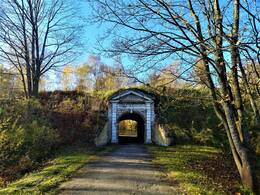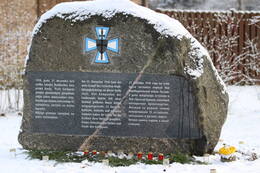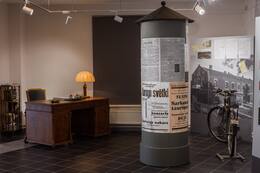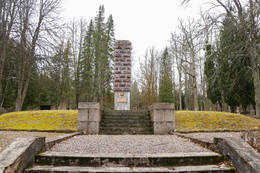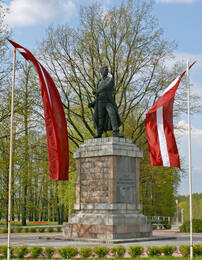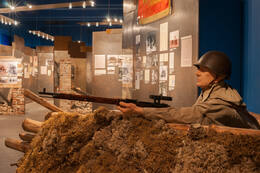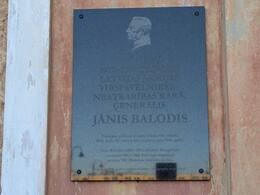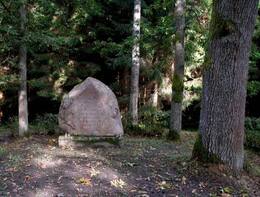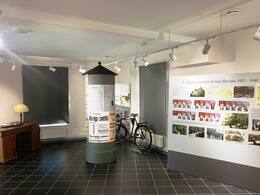Jānis Balodis (1881-1965), Latvijos kariuomenės vyriausiasis vadas, karo ministras generolas
I WW1, I Nepriklausomybės karai, II Antrasis pasaulinis karas, IV Sovietų okupacija

Janis Balodis gimė 1881 m. vasario 20 d. Trikatos parapijos „Vėženiekuose“. 1898 m. baigęs Trikatos parapijos mokyklą, jis savanoriškai įstojo į Rusijos kariuomenę, tarnavo Kaune 110-ajame Kamos pėstininkų pulke. 1902 m. baigęs Vilijos junkerių mokyklą, J. Balodis buvo paaukštintas pulkininku leitenantu ir paskirtas į 100-ąjį Ostrovos pėstininkų pulką. 1905 m. dalyvavo Rusijos-Japonijos kare, o jam pasibaigus tęsė tarnybą 106-ajame Ufos pėstininkų pulke Vilniuje.
Pirmojo pasaulinio karo metu, 1915 m. vasarį, kapitonas Janis Balodis buvo sužeistas netoli Gardino ir paimtas vokiečių nelaisvėn. Grįžęs iš nelaisvės, J. Balodis 1918 m. gruodžio 1 d. savanoriškai įstojo į Latvijos laikinosios vyriausybės ginkluotąsias pajėgas ir tapo Karininkų rezervo kuopos (vėliau – 1-osios Nepriklausomybės kuopos) vadu. Dalyvavo pirmuosiuose mūšiuose prie Lielaucės, Skrundos ir Ventos. 1919 m. vasario 28 d. už kovinius nuopelnus buvo paaukštintas iki generolo majoro (pulkininko leitenanto). Po pulkininko Oskaro Kalpako mirties Janis Balodis buvo paskirtas 1-ojo Latvijos atskirojo bataliono (vėliau – brigados) vadu, o netrukus – 1919 m. kovo 21 d. – jam buvo suteiktas pulkininko laipsnis.
Po Cėsių mūšio, kai 1919 m. liepos 6 d. Šiaurės Latvijos brigada įžengė į Rygą ir abi grupės susijungė į vieną nacionalinę armiją, Balodis buvo paskirtas naujai suformuotos 1-osios Kuršo divizijos vadu, taigi ir Latvijos kariuomenės vadu Rytų fronte. Šiose pareigose jis vykdė puolamąsias operacijas Latgaloje. 1919 m. spalio 16 d. jis buvo paskirtas Latvijos armijos vyriausiuoju vadu. Vadovaujama Janio Baložo, nedidelė Latvijos armija, remiama kaimyninių šalių, nugalėjo ir išvijo bermontininkus, o 1920 m. pradžioje sutriuškino bolševikus Latgaloje. 1920 m. sausio 23 d. jam buvo suteiktas generolo laipsnis. 1921 m. kovo mėn. Balodis buvo atleistas iš pareigų dėl jos likvidavimo ir armijos perėjimo prie taikos meto štabo sąrašo. 1921 m. liepos 1 d. jis savo prašymu išėjo į pensiją iš armijos. Baigęs karinę karjerą, generolas J. Balodis įsitraukė į politiką, nuo 1925 iki 1934 m. buvo Latvijos Respublikos Saeimos deputatu. 1925 m. spalio 26 d. jis buvo paskirtas Lačplėšio karo ordino tarybos nariu.
Janis Balodis buvo apdovanotas visais trimis Lačplėšio karo ordino laipsniais, taip pat daugybe užsienio apdovanojimų. Už nuopelnus šaliai jam kaip protėvių nuosavybė buvo suteiktas Baložių ūkis (anksčiau Upesmuiža) Līvbērzės parapijoje.
1931 m. gruodžio 7 d. J. Balodis buvo paskirtas karo ministru. Jis aktyviai dalyvavo 1934 m. gegužės 15 d. Kārlio Ulmanio įvykdytame valstybės perversme. Pagal 1936 m. kovo 12 d. įstatymą Balodis buvo skiriamas Respublikos prezidentu įstatymo numatytais atvejais.
Sovietų okupacijos metu, 1940 m. liepą, jis buvo suimtas ir kartu su žmona deportuotas į Syzranę, kur gyveno prižiūrimas saugumo institucijų. 1941 m., SSRS teritorijoje vykstant Antrajam pasauliniam karui, Balodis buvo suimtas ir uždarytas Kuibyševo kalėjime. 1946 m. jis buvo perkeltas į Ivanovo kalėjimą, bet 1952 m. kovo mėn. išsiųstas į Vladimiro kalėjimą.
Jānis Balodis buvo paleistas iš kalėjimo 1956 m. ir su žmona grįžo į Latviją. Jis gyveno Saulkrastuose, kur mirė 1965 m. rugpjūčio 8 d. Palaidotas Rygoje, I Mežos kapinėse.
Daugiau informacijos šaltinių
Ērikas Jēkabsons. Jānis Balodis. – Nacionalinė enciklopedija: https://enciklopedija.lv/skirklis/29969-J%C4%81nis-Balodis
Jānis Balodis. Atsiminimai. 1918–1939 m. metai, komp. A. Caune, Latvijos istorijos instituto leidykla, Ryga, 2015 m.
Andris Caune. Generolas Jānis Balodis Rusijos tremtyje ir kalėjime, 1940–1960, Latvijos istorijos instituto leidykla, Ryga, 2016 m.
Paskutiniai generolo Janio Baložo gyvenimo metai Latvijoje, 1956–1965 m., amžininkų prisiminimai ir liudijimai, sudar. A. Caune, Ryga, Latvijos istorijos instituto leidykla, 2014 m.
Lāčplėsio karo ordino kavalieriaus Janio Baložo biografija: http://lkok.com/detail1.asp?ID=2141
Susijusi laiko juosta
Susijusios vietos
Lāčplėsio karinio ordino generolų ir riterių atminimo vietos Trikātos valsčiuje
Atminimo stela yra šalia Trikatos kapinių koplyčios.
Trikātos kapinėse saugomas trijų iškilių Latvijos generolų – Roberto Dambīčio, Kārlio Gopperso ir Jānio Balodžio – atminimas. Trikātos kapinėse palaidotas ir visų šių generolų mokytojas Jēkabs Mūrnieks, kuriam 1928 metais palaidojimo vietoje buvo pastatytas paminklas iš travertino, sukurtas pagal Kārlio Zāle pavyzdį.
Lačplėsio karinio ordino generolai ir riteriai kasmet pagerbiami fakelų procesijomis į Trikatos kapines, kur yra dvi atminimo stelos, kuriose iškalti 17 su Trikatos parapija susijusių Lačplėsio karinio ordino riterių vardai.
Stela buvo atidengta 2018 m. lapkričio 11 d.
Vaizdo įrašas apie Lāčplės karo ordiną ir ordinų rinkinį , priklausiusį generolui Jāniui Balodiui.
Daugavgryvos tvirtovė
Daugavgryvos tvirtovė (įėjimas iš Birzės gatvės) yra Daugavgryvos saloje, kur Bulupės upė įteka į Dauguvos upę. Tvirtovė buvo pastatyta XVII a., siekiant apsiginti nuo priešų, judančių Rygos kryptimi, kuri buvo svarbus administracinis, prekybos ir gamybos centras. Vėliau ji tapo pagrindiniu Latvijos armijos pakrantės gynybos įtvirtinimu su keliais atramos taškais. Ši gynybinė įtvirtinimų sistema yra vienas vertingiausių Latvijos karinio paveldo objektų. Ši tvirtovė yra Latvijos karinės istorijos liudininkė. Pavyzdžiui, Krymo karo metu (1853–1856 m.) čia buvo mokomos Latvijos ir Estijos patrankinių valčių įgulos. Pagrindinis šių dalinių tikslas buvo ginti vietos uostus ir pakrantę nuo britų karinio jūrų laivyno atakų. Pirmojo pasaulinio karo metu čia buvo suformuotos Daugavgryvos milicijos kuopos. Tai buvo pirmieji Latvijos koviniai daliniai, atsiradę dar anksčiau nei Latvijos šauliai. Šiandien galima pamatyti tvirtovės teritoriją. Netoliese yra Kometfortas ir Pajūrio gamtos parkas, o kitoje Dauguvos pusėje – Mangaļsalos įtvirtinimai.
Paminklas pirmajam mūšiui už Latvijos nepriklausomybę
Adresas: Inčukalns, Atmodas g. 2.
2016 m. liepos 3 d. buvo atidengtas paminklas pirmajam mūšiui už Latvijos nepriklausomybę, skirtas Latvijos landesverui (Die Lettländische Landeswehr), kuriame vietos baltų vokiečiai, rusai ir latviai, tuo metu buvę abiejų pusių daliniuose, gynė naujai įkurtą valstybę nuo bolševikų Raudonosios Armijos. Brolių kapų komiteto pirmininkas Eiženas Upmanis tuo metu padarė išvadą, kad tai galėtų būti pirmasis paminklas jungtinėms Latvijos ir Baltijos vokiečių pajėgoms mūšio memorialuose už kapinių ribų. Tuo metu Latvijos landesvero latvių dalinių vadu buvo paskirtas pulkininkas leitenantas Oskaras Kalpaksas, iš kurio dalinių Laisvės kovų metu išaugo ir susiformavo vėlesnė Latvijos armija.
1918 m. visa dabartinės Latvijos teritorija pateko į Vokietijos imperijos ir jos kariuomenės rankas. Tačiau 1918 m. vasaros pabaigoje ir rudenį padėtis ėmė sparčiai keistis prieš Vokietiją ir tapo aišku, kad tik laiko klausimas, kada Vokietija bus priversta pripažinti pralaimėjimą Pirmajame pasauliniame kare. Rusijos imperija, kurios dalimi Latvija buvo iki Pirmojo pasaulinio karo, nustojo egzistuoti anksčiau, po 1917 m. vasario ir spalio revoliucijų. 1918 m. lapkričio 18 d. buvo paskelbta Latvijos Respublika. Vokietijos kariuomenė, kuri po 1918 m. lapkričio 11 d. paliaubų su Antantės valstybėmis buvo dislokuota Latvijos teritorijoje, nebebuvo motyvuota tolesniems karo veiksmams, ir dauguma jos kareivių tiesiog norėjo grįžti į tėvynę.
Tokiomis aplinkybėmis buvo akivaizdu, kad Latvijos gynyba pirmiausia priklausė nuo pačių Latvijos gyventojų suformuotos nacionalinės gvardijos. Iš pradžių, dėl savo išsilavinimo ir santykinai didesnio gebėjimo savarankiškai organizuotis, didžiausią iniciatyvą formuojant tokią nacionalinę gvardiją rodė Latvijoje gyvenantys Baltijos vokiečiai. Į nacionalinę gvardiją įstojo ir Rusijos kareiviai. Siekdama užtikrinti nacionalinės gvardijos aprūpinimą uniformomis, ginklais ir kitais reikalingais ištekliais, Latvijos laikinoji vyriausybė 1918 m. gruodžio 7 d. sudarė susitarimą su Vokietijos atstovu Augustu Vinnigu, numatantį nacionalinės gvardijos aprūpinimą iš Latvijos teritorijoje esančių Vokietijos armijos rezervų. Šiame susitarime, be kita ko, buvo nurodyta, kad ši nacionalinė gvardija, oficialiai vadinama „Latvijas zemessardze“ arba vokiškai „die Lettländische Landeswehr“, bus Latvijos Respublikos ginkluotosios pajėgos.
Latvijos nacionalinė gvardija susidūrė su dviem Latvijos raudonųjų šaulių pulkais (t. y. maždaug 2000–3000 karių), kurie anksčiau buvo patyrę Pirmajame pasauliniame kare ir Rusijos pilietiniame kare. Nepaisant Raudonosios armijos patirties ir skaitinės persvaros, Latvijos nacionalinė gvardija dvi dienas laikė Inčukalną įnirtingose kovose, kol galiausiai 1919 m. sausio 1 d. vakarą, norėdama išvengti apsupties, buvo priversta trauktis, praradusi 43 žuvusius ir kelis sužeistuosius, kurių dauguma buvo bolševikų sučiupti, kur žuvo arba mirė nuo bado ar ligų.
Autorius: Artis Buks. Medžiaga: lauko akmuo. Paminklas pagamintas iš didelio monolitinio akmens, rasto Ruļļuose netoli Jelgavos.
Paroda „Latvijos armija Pliavinėse XX amžiuje“.
Adresas: Odzienas g. 2, Pļavinės.
Eksponuojama nuolatinė ekspozicija „Latvijos armija Pliavinėse XX amžiuje“.
Pastatas Pliavinėse, Odzienos gatvėje 2, turi ilgą istoriją – nuo tada, kai „Stukmaņi“ didmenininkas „Hugo Apeltofts“ pradėjo jame aktyvią ūkinę veiklą ir taip prisidėjo prie Pliavinių miesto plėtros, iki to momento, kai Nepriklausomybės karo metu čia buvo įkurtas Latvijos Rytų fronto štabas. 1919 m. būtent iš Pliavinių buvo vadovaujamos Latvijos armijos dalinių operacijos prieš Raudonąją armiją Latgaloje.
1934 m. prie šių namų buvo atidengta memorialinė lenta su užrašu: „1919 m. šiuose namuose buvo įsikūręs Rytų fronto štabas, o čia generolas Janis Balodis perėmė vyriausiąją Latvijos nacionalinės armijos vadovybę.“ Sovietų valdžia ją 1940 m. pašalino ir sunaikino, tačiau 1990 m. birželio 16 d., padedant Latvijos nacionalinės išlaisvinimo armijos Pliavinės skyriui, ji buvo atstatyta.
Dabar šalia buvusio štabo pastato stovi memorialinė stela, skirta 15 Lačplėsio Karo ordino riterių, gimusių Pliavinos krašte, o patalpose sukurta paroda „Latvijos armija Pliavinoje XX amžiuje“, kurioje pasakojama apie Laisvės kovų įvykius, Latvijos armijos 3-iosios Latgalos divizijos štabo veiklą Pliavinoje, taip pat galima susipažinti su Lačplėsio Karo ordino riterių gyvenimo istorijomis.
Netoli parodų pastato yra Latgalos divizijos štabo pastatas, kurį 1913 m. kaip „Stukmanu“ likerio fabriką pastatė grafas Teodoras Medemas. 1919 m. jį perėmė P. Stučkos režimas, kuriame taip pat buvo įkurtas kalėjimas. Išvijus bolševikus, 1925 m. pastatą perėmė Latvijos armija, kurioje buvo įsikūręs Latgalos divizijos štabas. Šiame pastate savo karinę karjerą praleido 10 Latvijos armijos generolų ir kitų karininkų. 1940 m. pastatą perėmė Raudonoji armija. Pokario metais jame buvo įsikūrusi mokykla, taip pat savivaldybė. Apie 1970 m. pastatą pradėjo naudoti gamybos susivienijimas „Rīgas Apērbs“.
Parodą būtina apžiūrėti iš anksto telefonu 28442692.
Paminklas Tirzos parapijos nariams, žuvusiems laisvės kovose
Rasta Tirzos Kancėno kapinėse.
Matomas paminklas su liūto galva.
Paminklas iš skaldos riedulių, kurį suprojektavo architektas Aleksandras Birzenieksas ir skulptorius Vilhelmas Treijsas, užsakė Brolių kapinių komiteto Tirzos skyrius, o pagamino akmenininkas Blumbergas. Paminklas pastatytas Tirzos parapijos narių ir Brolių kapinių komiteto paaukotomis lėšomis. Paminklo fondui paaukoti 2377 latai. Atidengtas 1928 m. rugsėjo 9 d.
Paminklas pastatytas iš masyvių granito luitų, kvadratinės kolonos formos, ir palieka stiprybės bei nepriklausomybės simbolio įspūdį. Bronzines paminklo dalis ir dekoracijas sukūrė skulptorius Vilhelmas Trejs. Medžiaga: granitas, bronza, forma: architektūrinė kompozicija su vario kalinimu. Vienoje paminklo pusėje yra bronzinė liūto galva ir lenta su užrašu: „Šioje šventoje vietoje gerų žmonių dorybė sukūrė sau dvasinę buveinę.“. Kitoje pusėje parašyta: „Amžinam atminimui Tirzos parapijos sūnų, žuvusių kare ir laisvės kovose. Anno 1928.“.
Žinoma, kad paminklas buvo pašventintas atidarymo ceremonijoje 1928 m. rugsėjo 9 d., kurią atliko kunigas Edgaras Bergas. Atidarymo ceremonijoje taip pat dalyvavo legendinis generolas Janis Balodis, iškili asmenybė Latvijos istorijoje. Jis buvo vyriausiasis kariuomenės vadas kovose su bermontininkais ir Raudonąja armija Latgaloje. Po 1934 m. perversmo jis buvo antrasis asmuo šalyje ir toks išliko žmonių atmintyje net ir po 1940 m.
2008 m. paminklas buvo restauruotas, padedant Tirzos plėtros asociacijai.
Paminklas žuvusiems Latgalos partizanų pulko kariams 1919–1920 m.
Latvijos Nepriklausomybės karo (1918–1920 m.) metu Balvių krašte vietos gyventojų iniciatyva buvo suformuotas Balvių partizanų skyrius, kuris netrukus buvo pertvarkytas į Latgalos partizanų pulką.
Pulko paminklo idėja kilo dar 1927 m. 1933 m. buvęs Latgalos partizanų pulko kareivis ir akmenkalys Jānis Pilmanis savo lėšomis pastatė 5 metrų aukščio akmeninį paminklo postamentą. Patį bronzinį paminklą sukūrė menininkas Kārlis Jansons.
Paminklas, skirtas žuvusių pulko karių atminimui, buvo atidengtas 1938 m. rugpjūčio 14 d., dalyvaujant generolui Jāniui Balodžiui. Nors oficialus paminklo pavadinimas buvo „Sargybos partizanas“, netrukus žmonės paminklą ėmė vadinti tiesiog „Balva Stanislava“.
Latviją okupavus SSRS, 1941 m. pavasarį Abrenės apskrities vykdomojo komiteto sprendimu paminklas buvo nugriautas. Aukštas postamentas buvo nugriautas, tačiau pats bronzinis paminklas liko Balvų policijos kieme.
Vokiečių okupacijos metu paminklo postamentas nebuvo restauruotas, tačiau pats bronzinis paminklas buvo pastatytas ankstesnėje vietoje. Po antrojo sovietų okupantų sugrįžimo 1944 m. paminklas buvo visiškai sunaikintas.
Latvijai atgavus nepriklausomybę, Balvų gyventojai rinko aukas Latgalos partizanų paminklo restauravimui. 1993 m. lapkričio 11 d. Balvuose buvo atidengtas restauruotas paminklas, kurį sukūrė menininko Kārlio Jansono sūnus Andrejus Jansonas.
Prie paminklo pjedestalo galo pritvirtinta papildoma atminimo lenta su užrašu „Renovuota taip pat pagerbiant 1940–1954 m. Latgalos nacionalinės laisvės kovotojus“.
Latvijos karo muziejus
Latvijos karo muziejus yra įsikūręs senamiestyje, netoli Laisvės paminklo, istoriniame gynybos pastate, vadinamame „Parako bokštu“. Muziejuje yra 11 eksponatų. Čia eksponuojami įvairūs ginklai, dokumentai, uniformos, apdovanojimai, ženkleliai ir kiti daiktai, pasakojantys apie kasdienį kareivio gyvenimą kare. Latvijos karo muziejus yra vienas seniausių muziejų Latvijoje. Jo ištakos siekia Pirmąjį pasaulinį karą. Muziejaus kolekciją daugiausia sudarė asmeniniai kareivių daiktai arba mūšio laukuose rasti daiktai. Latvijai atgavus nepriklausomybę, pagrindinis muziejaus tikslas tapo sukurti ekspoziciją apie Latvijos karo istoriją ir aktyvų gyventojų vaidmenį saugant savo žemę. 1937 m. muziejus buvo išplėstas ir techniškai buvo vienas moderniausių tuo metu Europoje. Parako bokštas buvo vienas iš Rygos įtvirtinimų bokštų. Kai kurie įrodymai siekia 1330 m., kai jis buvo minimas kaip „Smėlio bokštas“. Bokštas buvo sugriautas 1621 m., kai Rygą apgulė Švedijos armija. Tačiau 1650 m. buvo pastatytas naujas bokštas parakui ir ginklams laikyti. Nugriovus miesto įtvirtinimus, Parako bokštas išlieka vienu svarbiausių Rygos gynybos sistemos įrodymų.
Atminimo lenta, skirta Latvijos armijos vyriausiajam vadui Janiui Balodžiui
Įsikūręs Daugpilio tvirtovėje, ant pastato sienos, priešais automobilių stovėjimo aikštelę.
Atminimo lenta byloja, kad šiame name (Oficieru gatvėje buvo karininkų namai) gyveno Latvijos armijos vyriausiasis vadas Nepriklausomybės karo metu – generolas Jānis Balodis (1881–1965). Atminimo lenta su šiuo tekstu buvo atidengta tarpukariu – 1936 m. rugsėjo 29 d., kai Latvijos armija buvo dislokuota Daugpilio tvirtovėje.
Jis buvo pašalintas po 1940 m., bet 2020 m. vėl įrengė Daugpilio paveldo asociacija.
Atminimo akmuo generolo Janio Baložo brigados mūšio vietoje
Atminimo akmuo generolo Janio Baložo brigados mūšio vietoje yra miške netoli Rygos–Liepojos (A9) greitkelio, šalia Batarų namo.
Atminimo akmuo buvo atidengtas 1936 m. iškilmingoje ceremonijoje, kurioje dalyvavo tuometinis susisiekimo ministras B. Einbergas ir kiti aukšti Rygos pareigūnai bei Džūkstės parapijos visuomenė, minint 1919 m. kovo 22 d. čia įvykusį mūšį. Ant paminklo iškaltas užrašas: „Čia 1919 m. kovo 22 d. įvyko 1-osios atskirosios Baložių brigados mūšis, kuriame žuvo 10 ir buvo sužeisti 28 kareiviai.“
Mūšis vyko tarp Atskirosios Latvijos brigados ir 10-ojo sovietų Latvijos šaulių pulko, kuriame 90 procentų buvo latviai. Laisvės kovų metu tai buvo vienas iš tų mūšių, kuriuose latviai kovojo su latviais. Bolševikai buvo įsitvirtinę Batarų namuose. Jie pradėjo apšaudyti brigados kareivius, einančius Kalnciemo kryptimi. Ugniai stiprėjant, brigada išsidėstė kovai. Pagrindinė mūšio našta teko Atskirajai Studentų kuopai ir Latvijos nepriklausomybės batalionui. Mūšiui užsitęsus, studentų kuopos būrys ir naujai suformuota kapitono E. Graudinio kuopa, atlikdami apėjimo manevrą, miške susidūrė su priešu, kuris atliko panašų manevrą. Įnirtingoje kovoje, kuri kai kuriose vietose virto artima kova, priešas buvo nugalėtas. Tuo metu brigadai priskirta vokiečių Millerio baterija atidengė ugnį į Batarų namus. Po artilerijos ugnies brigada greita ataka išstūmė priešą iš jo pozicijų.
Laikraštis „Brīvā Zeme“ (1936 m. gegužės 18 d.) paskelbė buvusio kovotojo prisiminimus: „Brigadavos kavalerija ką tik buvo išjojusi į atvirą lauką, kai juos pasitiko smarki priešo ugnis. Po to tapo aišku, kad jie susiduria su labai stipriomis priešo pajėgomis. Batalionai, generolo J. Baložo įsakymu, išsidėstė ir pradėjo kovoti, įsitraukdami į artimą kovą, nes brigados kareivių durtuvai šį dviejų valandų mūšį pavertė spindinčia kalpakiečių pergale. Šis mūšis buvo labai svarbus, nes sulygino padėtį fronte, kuris tapo nesaugus dėl vokiečių, ir užtikrino, kad raudonųjų šaulių pulkai nebepatektų į Žiemgalos lygumą.“
Generolo J. Baložo brigada laimėjo mūšį, pralaimėdama 10 kareivių, tarp jų – Kārlį Baroną (1900.8.III – 1919.22.III), Dainų tėvo Krišjanio Barono anūką, palaidotą Rygos brolių kapinėse. Mūšyje žuvo 50 sovietinio Latvijos šaulių pulko kareivių.
Ekspozicija „Latvijos kariuomenė Pliaviniose XX a.“
Ekzpozicija, skirta Latvijos kariuomenės kūrimosi istorijai, yra Pliaviniose. Pastatas, kuriame ji įrengta, turi ilgą istoriją. Kai buvo pastatyta Stukmanių (dabar Pliavinių) geležinkelio stotis, visoje apylinkėje buvo pradėti statyti namai. Vienas jų, pastatytas 1900 m., buvo pirklio Hugo Apeltofto namas. Iš pradžių statytas kaip pirklių namas, vėliau tapo vieta, kur pradėta formuoti Latvijos kariuomenė.
1919 m. liepą, vykstant Nepriklausomybės karams, čia įsikūrė Latvijos rytų fronto štabas. 1934 m. birželio 17 d. minint šį istorinį įvykį, ant pastato buvo atidengta atminimo lenta su įrašu: „Šiame name 1919 m. buvo įsikūręs Rytų fronto kariuomenės vado štabas, ir iš čia Janis Baluodis vadovavo kaip Latvijos nacionalinės kariuomenės vadas.“ 1990 m. birželio 16 d. atminimo lenta buvo restauruota. 2019 m. birželio 10 d. priešais buvusio štabo pastatą buvo pastatyta atminimo stela, skirta Pliavinių apylinkėje gimusiems kovotojams, apdovanotiems Lačplėsio karo ordinu.
Ekspozicijoje įrengti informaciniai stendai su istorinėmis nuotraukomis, žemėlapiais ir informacija apie Latvijos Rytų fronto štabo formavimąsi.
Susijusi istorija
Generolo Janio Baložo gyvenimas po grįžimo iš tremties
Kai 1940 m. rusai bandė išspausti iš Latvijos vyriausybės palankią karinės bazės sutartį, kuri būtų beveik neįmanomą Latvijos armijos gebėjimą pasipriešinti Raudonajai armijai, generolas J. Balodis bandė gauti kai kurias sutarties pataisas. Tačiau tai nepavyko. Tačiau generolo priešininkai pasinaudojo šia aplinkybe, kad vėliau J. Balodį paverstų beveik išdaviku. Po konflikto su ministru pirmininku ir valstybės ministru K. Ulmaniu generolas 1940 m. balandžio 5 d. buvo atleistas iš karo ministro pareigų. Tuomet J. Balodis nusprendė dalyvauti Saeimos rinkimuose iš Demokratinio bloko, tačiau nieko iš to neišėjo, nes rinkimuose buvo leista dalyvauti tik vienam sąrašui – komunistų kandidatų sąrašui. Latvija tapo 14-ąja sovietine respublika.
Oskaro Kalpako atminimui
Oskaro Kalpako atminimas saugomas daugelyje vietų – tai liudija jo gimtieji Liepsalu namai, paminklas Visagalos kapinėse, minėjimo renginiai ir gražūs koncertai kovo 6 d., Meirānu Kalpako pradinė mokykla, gatvės Lubanoje, Madonoje ir kituose miestuose ir taip toliau. Tačiau šiame straipsnyje – apie Oskaro Kalpako atminimo išsaugojimą gimtajame krašte XX a. 3–4 dešimtmečiais.
Cėsių mūšio pradžia, eiga ir pabaiga
Pergalė Cėsių mūšyje turėjo tapti lūžio tašku Latvijos ir Estijos kovoje už savo šalies nepriklausomybę. Ši pergalė sustabdė Andrijevo Niedros vyriausybės ir vokiečių generolo Rüdigerio fon der Golco planus užkariauti Pabaltijį. Vietoj to, Liepojoje savo veiklą atnaujino Karlio Ulmanio vadovaujama Laikinoji Latvijos vyriausybė.
Latvijos kariuomenės generolo, dukart Lāčplėsio karo ordino kavalieriaus Pēterio Radzinio atminimui.
Generolas Pēteris Radziņš gimė Lugažių valsčiuje, Valkos rajone, paprasto ūkininko šeimoje, kur išmoko dirbti lauko darbus. Jis buvo labai protingas jaunuolis, baigęs mokyklą pasirinko karą ir taip pradėjo savo karinę karjerą, gelbėdamas Latviją nuo Bermonto kariuomenės. P. Radziņš buvo vienas iškiliausių Latvijos armijos karininkų, apdovanotas daugybe Latvijos ir užsienio ordinų bei atminimo ženklų.
Apie Sidabrinio kalno atidarymo ceremoniją
Ištrauka iš prisiminimų istorijos iš generolo Jāņo Baložo kalbos Sudrabkalninio paminklo atidengimo dieną. Visas tekstas yra atidarymo renginio atpasakojimas, prezidento Kārlio Ulmanio ir generolo Jāņo Baložo kalbos. Prisiminimai pasirinkti, nes juose vaizdingai matyti Sudrabkalnino apylinkėse kovojančios Latvijos kariuomenės būklė.
Ball Mountain
Bumbu kalnas – aukšta kalva Bolderajos kopose, Kleistu miške, Rygoje. Latvijos laisvės kovų atminimo vieta. 1919 m. lapkritį, per Bermontiadas, čia buvo įsikūręs Krišjanio Berkio vadovaujamos Latgalos divizijos vadovavimo postas. Nuo Bumbu kalno puolęs 6-asis Rygos pėstininkų pulkas užėmė Sudrabkalninį. 1939 m. buvo įrengta atminimo lenta, kuri buvo sunaikinta 1969 m. Atminimo vieta atkurta 1989 m.
Apie mažiau žinomus latvių skulptoriaus Kārlio Zāles kūrinius senosiose Dīvalos ir Trikātos kapinėse
Vienas iš mažai žinomų skulptoriaus Kārlio Zālės (1888–1942) darbų yra travertino skulptūra „Nukritusios rožės“, sukurta 1939–1940 m. ir siejama su Brolių kapinių ansamblio sukūrimu.









